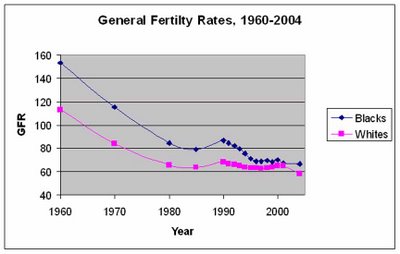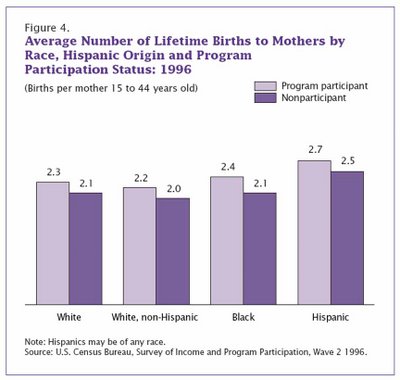It seems that no matter how many times I point this out to my Dan-Rather-obsessed friend "rdw", he keeps insisting that welfare reform of the mid-90s is responsible for bringing black fertility rates down. I thought I'd draw up a couple of charts to show that the data conclusively refute this notion. Below are the general fertility rates for whites and blacks from the period 1960 to 2004. (All data come from the CDC's National Center for Health Statistics; 1990-2001 data from here; 2004 preliminary data from here; General Fertility is defined as the number of children by women of child-bearing age (15-44) per 1000.)
The important thing to note here is that fertility rates were far, far higher back in the 60s and 70s than they are today, and they dropped precipitously during this era as the Baby Boom was ending. Since then, changes in fertility have been slight. Any changes that we see during the 90s are not particularly noteworthy by historical standards. But let's zoom and see what's happened since 1990 to get an idea of how welfare reform may have impacted black fertility rates.
Here we see what welfare reform did to the black fertility rate: Apparently nothing. Fertility rates dropped during the early part of the 1990s, this being after a small but measurable increase during the late 80s. But after 1996, the year in which welfare reform was enacted, fertility rates remained mostly flat. When I pointed this out to "rdw", his only response was to initmate that the mere threat of future welfare reform during the early 90s was enough to make black women stop having babies, a bullshit hypothesis that so smacks of desperation it doesn't merit a response.
My point here isn't that welfare reform wasn't a good idea. Maybe it was and maybe it wasn't, I haven't really analyzed the whole thing enough to make a sound judgment. But it was clearly sold on false pretenses, the idea that welfare mothers are 1) black, and 2) out-of-control child-bearing machines constantly churning out more babies in order to get more benefits. I'm rather curious as to where this notion came from, because it clearly has no basis in reality. First of all, only 30% of welfare recipients are black. That's greater than the black proportion of the population, but it's still only a minority of all welfare recipients, most of whom are white. And secondly, aside from negative racial stereotypes, there was never any evidence that your average welfare mother had a half-dozen kids and was busy popping out more in order to get increased benefits. Below is a graph showing the difference in total fertility rate in 1996 between women who participated in one or more welfare programs and those who did not (source).
You can see that the difference is very small. For black women, the difference of 2.4 vs. 2.1 means that on average, a welfare recipient has an extra 0.3 children per lifetime than someone who is not on welfare. This difference, as small as it is, can be explained entirely due to the effects of poverty (indeed, for those welfare recipients who are not below the poverty line, there is no difference in fertility between them and non-recipients). And it certainly doesn't support the stereotype of welfare mothers churning out baby after baby. The average welfare family, in terms of children at least, is basically indistinguishable from any other family.
The cynic in me says that this idea was created and spread in order to sell welfare reform, which otherwise wouldn't have been very popular. Polls routinely show that a large majority of Americans, about 70%, favor increased aid to the poor, yet the word "welfare" tends to carry negative connotations. Fomenting racial stereotypes is one way to separate the policy of "welfare" from the mere concept of helping the less fortunate.
Perhaps the most infamous example of this was Ronald Reagan's oft-told story of a Cadillac-driving "Welfare Queen" living in Chicago, a lazy black woman with bunches of children that was drawing benefits of over $150,000 by using 80 aliases. Reagan mentioned this woman in dozens of speeches over a five-year period, but there's one little problem: She never existed. Reagan, or rather one of his lackyes, created this caricature by exaggerating the case of a woman who had used 2 aliases to bilk the gummint out of a mere $8000, a crime for which she was convicted.
But even after it had been exposed as a big fat lie, Reagan kept using it. It did much to help create the stereotype of welfare recipients being lazy, fertile, and above all, black. This kind of social narrative has a powerful hold on the imagination, as we see with those who refuse to give it up long after it's been shown to be false.
Sunday, March 26, 2006
More on Welfare and Fertility
Posted by
Steve Reuland
at
3/26/2006 12:17:00 PM
![]()